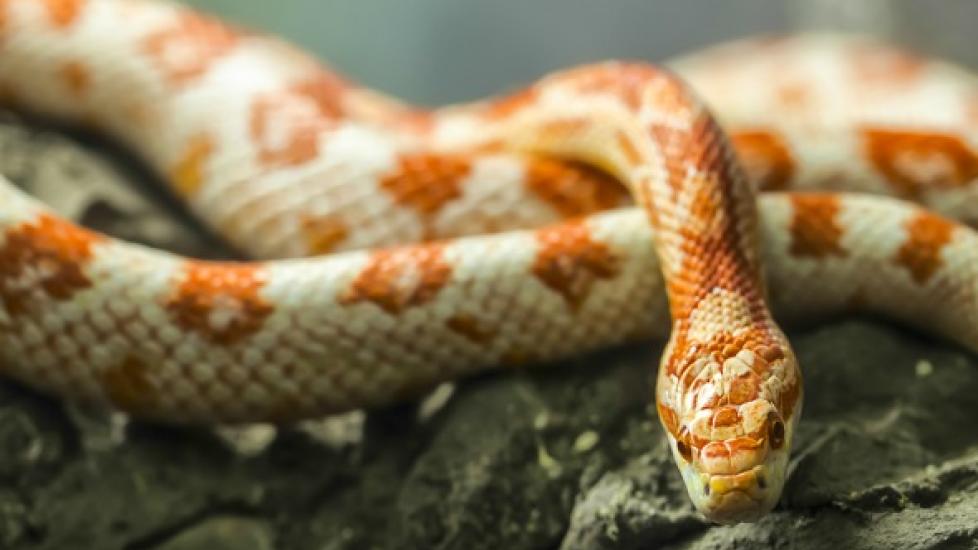What Do Corn Snakes Eat & How to Care for Them
Snake Bytes: Corn Snake Care
If you’re thinking that corn snakes are snakes made of corn, we’ll give you points for imagination, but unfortunately, you are wrong. A corn snake is, in fact, a relatively small and harmless North American snake that gets its name from the corn-like pattern on its skin.
Corn snakes make great first pets for a responsible kid that has a keen interest in snakes, but it is still important to do thorough research before getting the snake to make sure it is a good fit and that you're up for the commitment
How Big Do Corn Snakes Get and How Long Do They Live?
Once fully grown, corn snakes usually range from 2.5 to 5 feet in length, and have a lifespan of 5 to 10 years. They can even live longer when given proper care, so please make sure you are ready for a long-term commitment.
Choosing Your New Pet
When you're ready to choose your corn snake, look for one with no cuts or abrasions, and with bright, alert eyes and a flicking tongue. These are all signs of a healthy snake.
Now, on to the nitty-gritty: caring for a corn snake.
Corn Snake Tanks
Remember that reptiles, like other creatures, will grow to their proper size, regardless of whether you have a big or small space for them. As no one (particularly your snake) enjoys cramped quarters, a roomy home is of utmost importance. A 30- to 40-gallon tank should be large enough for your corn snake to move and grow in.
As with any snake tank, however, you’ll need to have a secured top to prevent any great escapes by your snake. A mesh lid is probably best, so that the tank will have appropriate ventilation. Corn snakes need to be kept in a temperature of 75 to 85 degrees Fahrenheit, which is pretty easy to achieve with a warming lamp set over the tank. The tank should have a "warm" zone (82 degrees) and a cool zone, with a hiding area available in each zone. Your local pet shop will have a selection to choose from. Heat rocks, meanwhile, are generally not recommended because snakes have sensitive skin that is prone to burns. Do not use reptile sand as bedding on the bottom of the tank, it can get into their nostrils and cause congestion. Pine bedding is not recommended either, as the oils can be toxic to corn snake.
To keep your corn snake happy and stress free, it’s a great idea to fill the tank with plants, branches for curling around on, and boxes to hide in. Snakes can get traumatized when they have no place to hide, so give your snake both room to move and accessories to feel secure. Just make sure not to use live plants, as the fertilizer in the soil can be harmful to the snake. Use rocks and treated wood available in pet stores.
What Do Corn Snakes Eat?
Corn snakes primarily eat rodents. They are constrictor snakes, meaning that they catch thier prey and squeeze it. Even if you are feeding your snake dead rodents, you may want to give your snake the feeling that it is catching its own food. When it comes to mealtime, defrost the (dead) mouse and let it warm to room temperature. Offer it to the snake by holding it by the tail (feeding forceps are a really good idea) and dangle the mouse in front of the snake so it can strike the mouse, grab it, and go to work at swallowing its meal.
Quail eggs make great treats for your snake, but only occasionally -- about one every few weeks. Keep in mind that in the wild, eggs are an uncommon treat, not part of a regular diet. Fresh, clean water should always be available. This is essential.
Preventing Illness
To avoid bacteria and fungus from accumulating in the tank, make sure to clean the tank regularly, removing feces and urine as soon as possible. Snakes shed their old skin as they grow, and this is an amazing process to observe, since they shed their entire skin, slipping out of it like an old stocking.
When the time comes for your corn snake to shed, you will notice that its eyes will turn milky blue a few days before, its skin will go dull and it will take on a whitish sheen. When its eyes clear again, the snake is ready to shed. You can give your snake a shallow dish of tepid water to soak itself in as it goes through the shedding process.
Corn snakes, like other creatures, are susceptible to parasites and illnesses -- many of which are deadly. Because of this, have your snake tested for parasites when you first purchase the animal. If your snake is listless or sick, take any vomit or feces along to the veterinarian for testing.
Final Corn Snake Care Tips
So now you have a few facts under your belt. But consider this before you bring a snake home: make sure that no one in your home is very afraid of snakes (ophidiophobia), and think very carefully before bringing a snake into a home with small children, as toddlers don't have the maturity to remember rules about not opening tanks, and they have not yet learned how to be gentle with small creatures.
